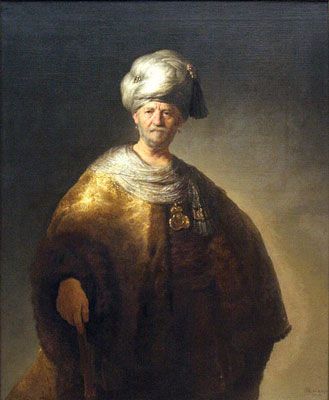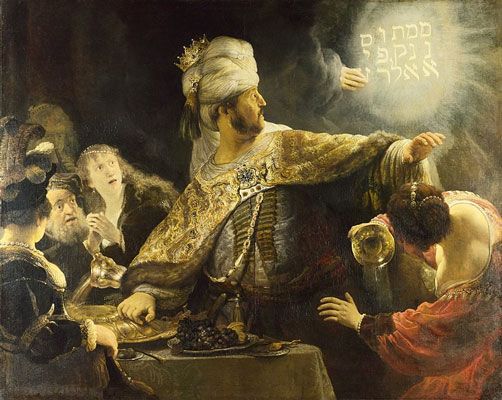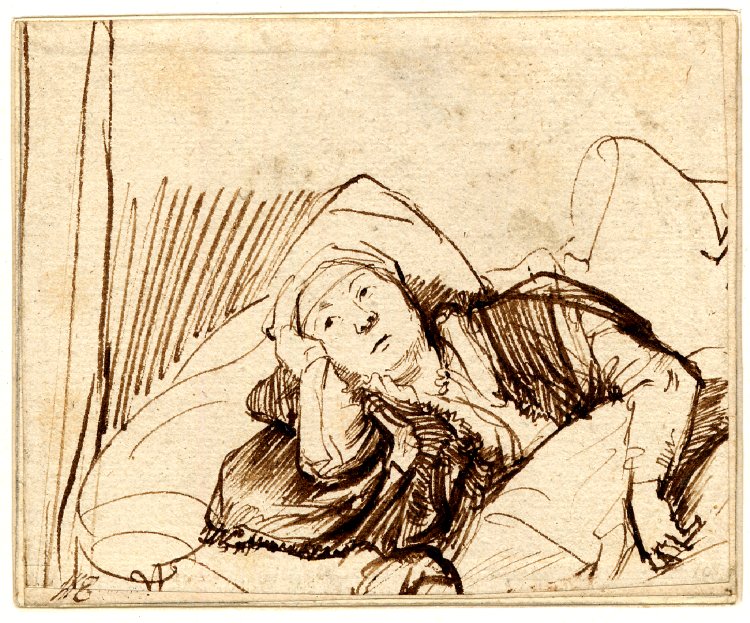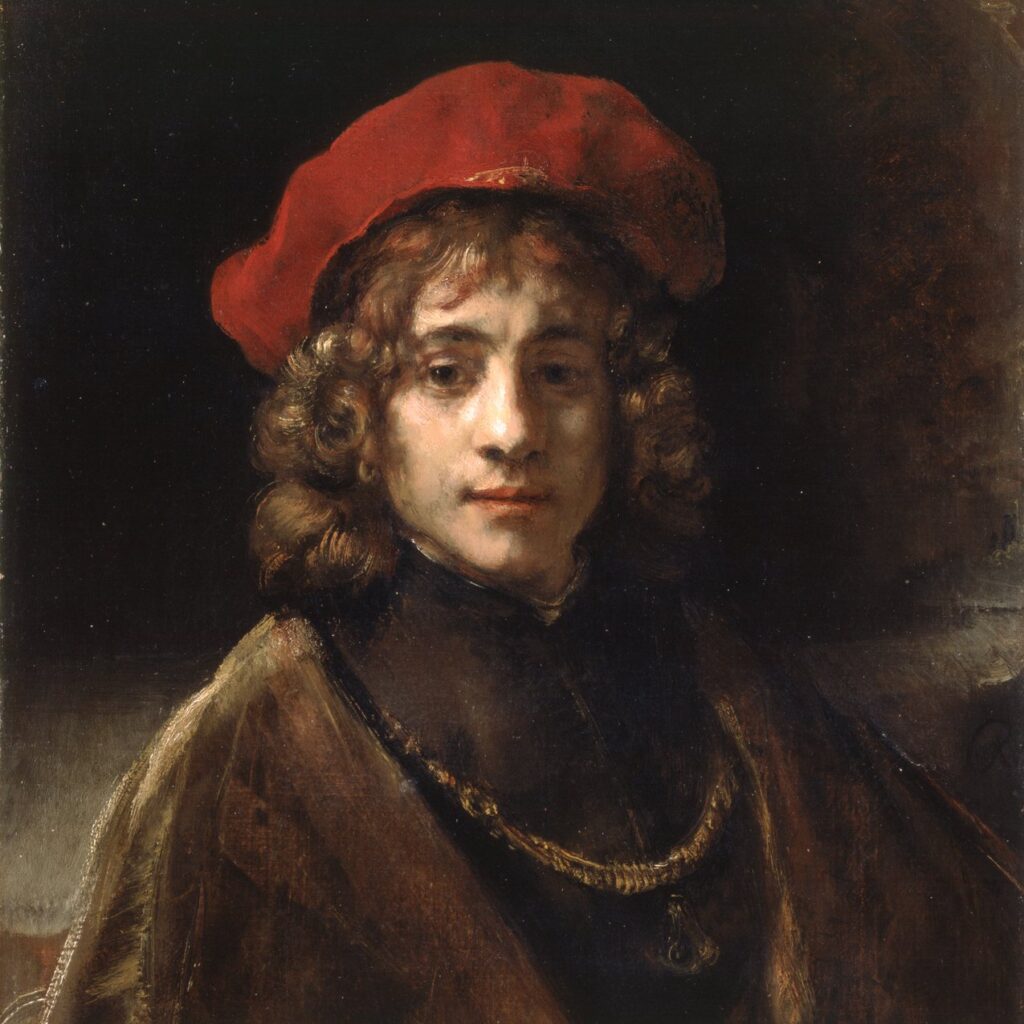Rembrandt
Portrait of Maria Trip is on display at the North Norfolk Information Centre
Born: July 15, 1607 – Leiden, Netherlands Died: October 4, 1669 – Amsterdam
Rembrandt van Rijn was a Dutch Golden Age Painter, printmaker and draughtsman. An innovative and prolific master in three media, he is generally considered one of the greatest visual artists in the history of art and the most important in Dutch art history. His works depict a wide range of style and subject matter, from portraits and self-portraits to landscapes, genre pictures, allegorical and historical scenes, animal studies and biblical and mythological scenes.
Building a Career
Rembrandt van Rijn was the eighth of nine or more children born to Harmen van Rijn, a corn miller, and Cornelia van Zuijtbrouck, a baker’s daughter. They were a prosperous family and lived in Leiden near the River Rhine, their lives were much occupied with religion and education. Cornelia read the Scriptures to her children, instilling a strong sense of God, man, and nature in the young Rembrandt. A talented child, from age 7 to 14 he was sent to the Latin school in Leiden for a classical education. Aged 14 he was admitted to the University of Leiden, by now he was avidly painting and drawing, so after a few months he withdrew to dedicate himself to art.
Rembrandt started on a three-year apprenticeship with Jacob Swanenburgh who taught him the fundamentals of painting, drawing, and etching. Then his father sent him to Amsterdam to study with Pieter Lastman, a skilled Italian painter who had studied the works of Caravaggio. Here, after some months, Rembrandt had mastered the techniques of chiaroscuro as well as the use of bright glossy colors and posing figures with theatrical gestures. Lastman also influenced Rembrandt to concentrate on historical and religious scenes although the local art buyers preferred scenes from their daily lives. Rembrandt is quoted as saying, “Painting is the grandchild of nature. It is related to God.”
Around 1625 aged just 18 or 19, Rembrandt had grown in confidence, was more refined and dressed well. He returned to Leiden to set up his own studio with his friend and colleague, Jan Lievens, who had also studied under Lastman. In 1629, Rembrandt met Constantijn Huygens who ran an art academy where copies of paintings were made and commissions were fulfilled. Huygens was a statesman for the court of The Hague and could negotiate commissions for his artists. Though still very young Rembrandt and Leivens took life and their work seriously, Huygens stated: “…I have never observed such dedication and persistence in other men whatever their pursuits or ages. Truly these youths are redeeming the time. That is their sole consolation. Most amazingly they regard even the most innocent diversions of youth as a waste of time, as if they were already burdened with age and long past follies.”
In 1632, Rembrandt returned to the more wealthy metropolis of Amsterdam. Here he found recognition as a professional portrait painter and soon became known as a prosperous and fashionable young artist. Commissions came from successful businessmen, intellectuals, and religious leaders whose portraits proclaimed the wealth, position and taste of the sitters. In 1632, Rembrandt painted a group portrait called The Anatomy Lesson of Dr. Tulp, which brought him enormous attention. That same year, he became a burgess of Amsterdam and a member of the local guild of painters.
Rembrandt had a deep understanding of the importance of detail in the depiction of the world around him. He was renowned for his outstanding ability to paint very natural, realistic human figures but even more importantly, to portray deep human feelings and imperfections. He had many students and apprentices who were eager to learn from him, and his influence on painters around him was so great that it is difficult to tell whether someone worked for him in his studio or just copied his style for patrons eager to acquire a Rembrandt.
In Amsterdam Rembrandt lodged with an art dealer, Hendrick van Uylenburgh, and here he met Hendrick’s cousin Saskia van Uylenburgh, the daughter of a wealthy burgomaster. They married in 1634 and his new wife was able to introduce him to notable members of society through her well-connected extended family.

Throughout the 1630s, Rembrandt produced at least 65 commissioned portraits. He also painted biblical and mythological paintings, landscapes, and portraits of anonymous people who interested him such as Jewish people, officers in uniforms, or foreigners in exotic dress. Like many wealthy men of the time, Rembrandt collected works of art but also armour, costumes, Oriental turbans, and other curiosities from foreign places. He visited auctions and bought old fashioned or bizarre clothing which he thought picturesque. Some of these acquisitions often ended up as props in his work and self portraits. He was now at the height of his powers and reputation, enjoying a rich quality of life
In 1635, Rembrandt and Saskia rented a house in a wealthy part of Amsterdam which was soon to be known as the Jewish quarter. Here Rembrandt engaged his Jewish neighbours to model for his Old Testament scenes. But sadly, the couple suffered several personal tragedies. Their son Rumbartus died two months after his birth in 1635 and their daughter Cornelia died at just three weeks old in 1638. In 1640 their second daughter, also named Cornelia, died only one month of age. In 1641, their son Titus was born and he survived into adulthood, but Saskia died soon after his birth, probably from tuberculosis
Stylistically, his paintings progressed from the early “smooth” manner, using fine brush technique in the portrayal of form, to the late “rough” treatment of richly variegated paint surfaces, which created an illusion of form suggested by the tactile quality of the paint itself.
Rembrandt produced etchings for most of his career, from 1626 to 1660, when he was forced to sell his printing-press and practically abandoned etching. As his paintings matured so did his skill as a printmaker, particularly from the late 1640s onward, the freedom and breadth of his drawings and paintings found expression in the print medium as well. The works encompass a wide range of subject matter and technique, sometimes leaving large areas of white paper to suggest space, at other times employing complex webs of line to produce rich dark tones.
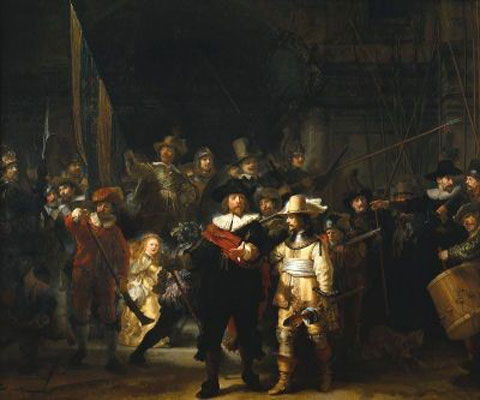
In contrast to his religious beliefs, Rembrandt’s private life was a morass of controversy. From his relationships with women to the management of his personal finances. His private life teetered on the edge of disarray and chaos whilst his public persona showed great career achievements and public popularity.
In 1642, Rembrandt hired a widow of peasant stock named Geertghe Dircx to help care for Titus. She soon became Rembrandt’s lover but this was not a happy relationship. He behaved badly, got into debt and fell out of favour with his friends and patrons. Geertghe later charged Rembrandt with breach of promise and she was awarded annual financial support. After learning that she had pawned some of Saskia’s jewelry Rembrandt finally managed to have her committed to a poorhouse. However, he still felt obliged to pay for her to live at a house of correction from 1650 to 1655 even though his own financial situation was precarious.
The Downhill Spiral
Around 1647, Rembrandt hired Hendrickje Stoffels as house maid. She was 20 years his younger and soon became his model and his lover, now domestic life with Geertghe became very difficult. Hendricke had two daughters with Rembrandt, one died as an infant, but the other, Cornelia, survived. Rembrandt now seemed to regain his equilibrium with Hendrickje, maturity brought more stability to his family life and art and he produced several masterpieces. However, in the mid 1640’s Dutch artistic tastes began to change, the Flemish artist Anthony van Dyck with brightly his coloured and elegant subjects was in the vanguard of this new popular style. Rembrandt’s work was seen as old-fashioned, his biblical themes were not wanted and there were very few commissions.
At this time Rembrandt’s landscape paintings, etchings and drawings showed great originality and keen observation of natural forms. The Mill (1645–48) has all the characteristics of having been painted from life, although it probably was not, since that was rare in seventeenth-century Dutch landscape painting. The collectors and critics celebrated the dramatic silhouette of the mill against a dark, stormy sky and attributed the heavy atmosphere to Rembrandt’s frame of mind as he worked through his financial difficulties.
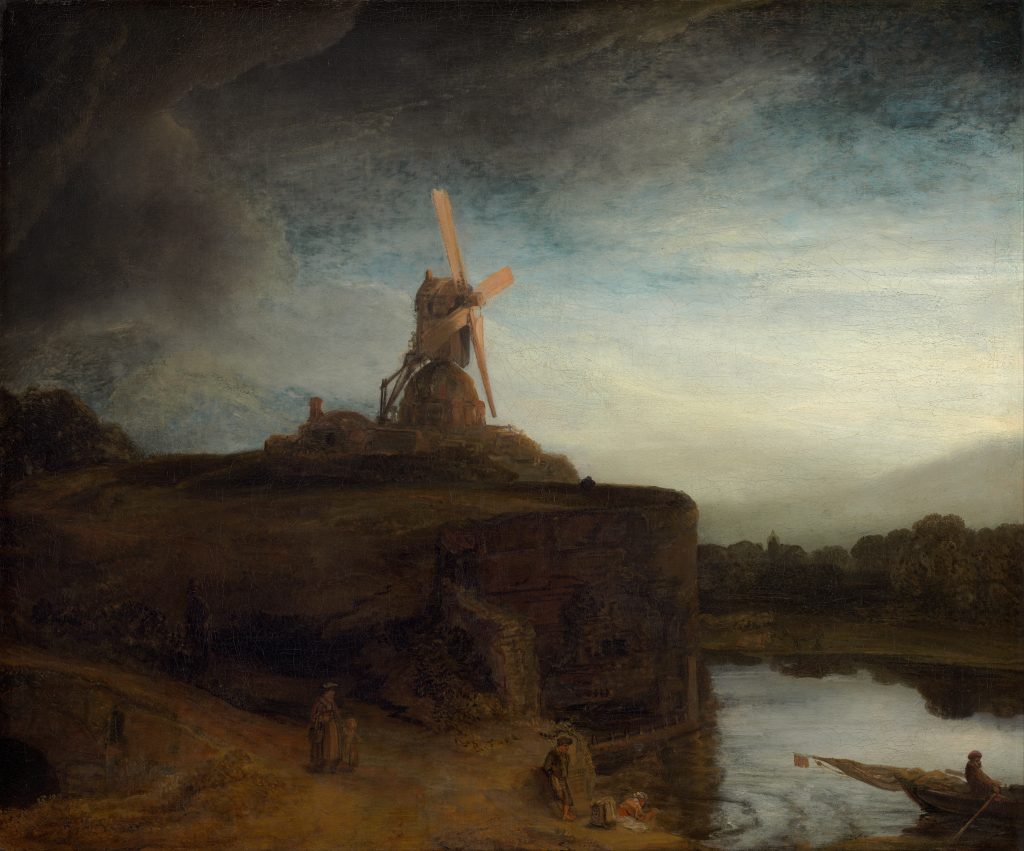
Rembrandt certainly lived beyond his means, bidding up his own work at sales to increase his profit, and buying paintings and prints to add to his own collection. Eventually, in 1657, the court put a stop to things and arranged an auction of his work and belongings. To avoid bankruptcy he was forced to sell most of his prized possessions, which included Roman busts, Japanese armor and Asian objects, paintings, and a large collection of antiquities, but he was allowed to keeep his tools. Later he was forced to sell his house and printing press and moved to a more modest dwelling on the outskirts of Amsterdam with Hendrickje and Titus.
To add to his problems the Amsterdam Painter’s Guild introduced a new ruling that artists with poor financial assets could not trade as a painter. In a clever move to circumvent this ban Hendrickje and Titus set up in partnership as art dealers with Rembrandt as their employee. So by 1662, via this new business, Rembrandt was once more fulfilling major commissions for individual portraits, group portraits, and other works.
Rembrandt outlived Hendrickje, who died in 1663 aged 37, and Titus who died in 1668 aged just 27. Rembrandt died in 1669 at the age of 62 and was buried as a pauper in an unmarked grave in Amsterdam. After twenty years, his remains were removed and destroyed, the usual procedure for poor burials.
Credits:




